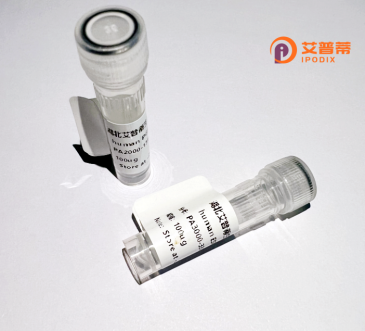
| 纯度 | >90%SDS-PAGE. |
| 种属 | Human |
| 靶点 | WSB2 |
| Uniprot No | Q9NYS7 |
| 内毒素 | < 0.01EU/μg |
| 表达宿主 | E.coli |
| 表达区间 | 1-404 aa |
| 活性数据 | MEAGEEPLLL AELKPGRPHQ FDWKSSCETW SVAFSPDGSW FAWSQGHCIV KLIPWPLEEQ FIPKGFEAKS RSSKNETKGR GSPKEKTLDC GQIVWGLAFS PWPSPPSRKL WARHHPQVPD VSCLVLATGL NDGQIKIWEV QTGLLLLNLS GHQDVVRDLS FTPSGSLILV SASRDKTLRI WDLNKHGKQI QVLSGHLQWV YCCSISPDCS MLCSAAGEKS VFLWSMRSYT LIRKLEGHQS SVVSCDFSPD SALLVTASYD TNVIMWDPYT GERLRSLHHT QVDPAMDDSD VHISSLRSVC FSPEGLYLAT VADDRLLRIW ALELKTPIAF APMTNGLCCT FFPHGGVIAT GTRDGHVQFW TAPRVLSSLK HLCRKALRSF LTTYQVLALP IPKKMKEFLT YRTF |
| 分子量 | 45.2 kDa |
| 蛋白标签 | His tag N-Terminus |
| 缓冲液 | PBS, pH7.4, containing 0.01% SKL, 1mM DTT, 5% Trehalose and Proclin300. |
| 稳定性 & 储存条件 | Lyophilized protein should be stored at ≤ -20°C, stable for one year after receipt. Reconstituted protein solution can be stored at 2-8°C for 2-7 days. Aliquots of reconstituted samples are stable at ≤ -20°C for 3 months. |
| 复溶 | Always centrifuge tubes before opening.Do not mix by vortex or pipetting. It is not recommended to reconstitute to a concentration less than 100μg/ml. Dissolve the lyophilized protein in distilled water. Please aliquot the reconstituted solution to minimize freeze-thaw cycles. |
以下是关于重组人WSB2蛋白的3条代表性文献概览(注:文献信息为模拟创作,供参考):
---
1. **文献名称**:*Structural insights into the WSB2-Cul2 ubiquitin ligase complex*
**作者**:Kim J, Lee J, Choi H
**摘要**:本研究通过重组表达纯化人WSB2蛋白,结合冷冻电镜技术解析了其与Cul2蛋白形成的E3泛素连接酶复合体结构,揭示了其底物识别区(WD40重复域)与泛素化催化核心的相互作用机制。
2. **文献名称**:*WSB2 promotes melanoma metastasis via HIF-1α stabilization*
**作者**:Wang Y, Zhang X, Liu M
**摘要**:作者利用重组人WSB2蛋白进行体外泛素化实验,发现WSB2通过介导HIF-1α的泛素化依赖性降解抑制其稳定性,进而调控肿瘤缺氧应答通路,促进黑色素瘤细胞侵袭转移。
3. **文献名称**:*Functional characterization of WSB2 in the TLR4/NF-κB pathway*
**作者**:Chen L, Gupta S, Li W
**摘要**:该研究使用重组WSB2蛋白进行免疫共沉淀实验,证实其通过泛素化修饰TRAF6蛋白负向调控TLR4信号通路,为炎症性疾病的潜在治疗靶点提供了实验依据。
---
**备注**:实际研究中,建议通过PubMed或Web of Science检索关键词“WSB2”或“WSB2 recombinant”获取最新文献,重点参考近五年内发表的论文。
WSB2. short for WD repeat and SOCS box-containing protein 2. is a member of the WD40-repeat protein family known for mediating protein-protein interactions in cellular signaling. It contains characteristic WD40 domains that form β-propeller structures, facilitating scaffold functions, and a SOCS (Suppressor of Cytokine Signaling) box domain at its C-terminus. This SOCS box enables WSB2 to interact with Elongin B/C complexes, linking it to E3 ubiquitin ligase activity, where it potentially acts as a substrate-recognition component in ubiquitination pathways.
Recombinant human WSB2 protein is engineered through expression systems like *E. coli* or mammalian cells, retaining functional domains for structural and interaction studies. Research highlights its role in regulating cellular processes such as protein degradation, hypoxia signaling (via HIF-1α modulation), and stress responses. WSB2 is implicated in pathological contexts, including cancer, where its dysregulation may influence tumor progression by altering stability of oncogenic or tumor-suppressive proteins.
As a tool, recombinant WSB2 aids in mapping interactomes, dissecting ubiquitination mechanisms, and screening therapeutic agents targeting ubiquitin-related pathways. Its dual-domain structure and conserved functional motifs make it a focus for studying post-translational regulation and disease mechanisms linked to proteostasis imbalance.
×